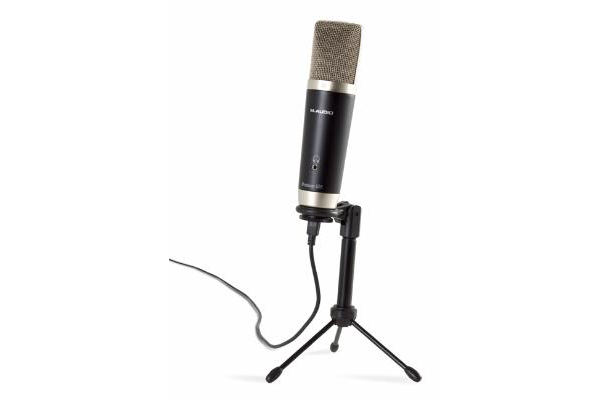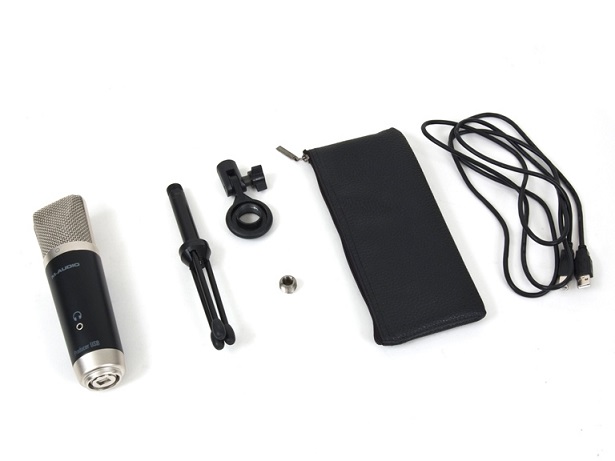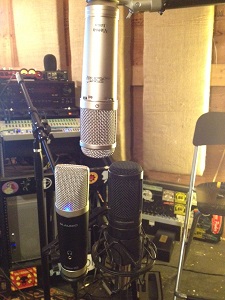 USB Microphones started becoming available to consumers as early as late 2005. At first, they were largely ignored and poo-poo’d in professional audio circles, but it didn’t take long for microphone manufacturers to take notice of this new market and start introducing USB microphones that caused some recordists to pause and take notice.
USB Microphones started becoming available to consumers as early as late 2005. At first, they were largely ignored and poo-poo’d in professional audio circles, but it didn’t take long for microphone manufacturers to take notice of this new market and start introducing USB microphones that caused some recordists to pause and take notice.
USB Gets Some Respect
The M-Audio Producer USB was introduced in this first wave of USB microphones that, at first glance, look exactly like studio side-address condenser (or capacitor if you’re from Great Britain) microphones. The intent of these microphones was to be an alternative for home musicians, podcasters and recordists who wanted a good quality microphone that didn’t require specialized interfaces and pre amplifiers.
This microphone is now packaged with an entry-level M-Audio branded audio recording application called Ignite as the “M-Audio Vocal Studio USB Mic with Ignite”. Best Buy carries this in their Musical Instrument department.

In essence, The M-Audio Producer USB (and many other USB microphones) operates as an audio interface and microphone all in one.
The Techie, Geeky Details
The microphone has a nice heft to it – around three pounds. The body of the microphone is a brushed metallic black bookended by a brushed silver cap on the bottom and grill on the top. The microphone is technically a small diaphragm mic as the capsule is roughly 16 mm in diameter (any microphone capsule that is less than an inch – 25 mm – in diameter is considered to be a small diaphragm). There is a 3.5mm headphone jack near the bottom of the front side of the microphone and a standard USB connection at the bottom where you’d typically find an XLR connection on standard side-address microphones.
The microphone comes with a desktop tripod stand, a mount, a faux leather carrying case and a nice length USB cable. The tripod stand is made with portability in mind – rather than isolation or stability. Other than holding the microphone upright and at proper speaking height when placed on a desk, the stand is not incredibly useful. Thankfully, the mount was made with the proper threads to attach to a standard microphone stand or boom. In addition to stability issues, the materials stand does very little to attenuate desktop or tabletop vibrations from getting into the microphone. Any bumps, scrapes or knocks from the desk are easily picked up by the microphone when mounted on the included stand.
 USB in Use
USB in Use
Setup and use of the M-Audio Producer USB was simple, short and sweet on both Mac and Windows platforms. As an acid test, I gave my kids a go with the microphone – with no instructions – just to see how far they could get with it on their Windows laptop. Within a few minutes, drivers were automatically downloaded and installed and they were using it to Skype with their friends. On the Mac platform, the microphone was immediately recognized and ready for use moments after being plugged in.
When the microphone is connected to the USB outlet, a small blue LED light on the front of the microphone just behind the grill lights up to let you know that it is connected.
Wishing for Bells and Whistles
The absence of any hardware controls on the microphone give it a sleek, professional look. However, throughout my use of this microphone, I found myself constantly wishing that there were controls to manage pre-amp gain and headphone volume on the microphone. Having to rely on software controls to manage those functions quickly became frustrating.
Testing! 1-2 …
As with all microphone reviews, they are incomplete without a sound test. For the price point, and considering that no external audio interface or preamp is required, the sound of the microphone was quite good. In my opinion, this microphone isn’t going to replace any of the workhorse mics in a professional studio closet, but it would be something that could capture singer-songwriter ideas and possibly be the default for a podcaster.
 Sonically, the microphone has a nice presence for voice over and perhaps acoustic instruments such as guitar – it captures a healthy chunk of the detail of the sound. The main drawback of the microphone is the self-noise. An audible noise-floor was present on both the Mac and Windows platform. I didn’t put it through an exhaustive battery of tests, but I wouldn’t call this microphone “flat”. I could hear that the lows (and some mid-lows) were attenuated. I also felt that some of the highs captured by the microphone were missing that nice shimmer that you expect from a condenser.
Sonically, the microphone has a nice presence for voice over and perhaps acoustic instruments such as guitar – it captures a healthy chunk of the detail of the sound. The main drawback of the microphone is the self-noise. An audible noise-floor was present on both the Mac and Windows platform. I didn’t put it through an exhaustive battery of tests, but I wouldn’t call this microphone “flat”. I could hear that the lows (and some mid-lows) were attenuated. I also felt that some of the highs captured by the microphone were missing that nice shimmer that you expect from a condenser.
As a comparison, I recorded identical clips of my voice and playing acoustic guitar (more like butchering the instrument) using the M-Audio Producer USB, an Audio-Technica AT2020 and an ADK Vienna Mk8. The AT2020 and the Vienna are both traditional XLR condenser microphones and both went through a Focusrite Saffire Pro 24 preamp/interface. By itself, the AT2020 is roughly the same price as the M-Audio Producer USB while the Vienna typically sells for roughly $US350.
All of the clips were gain-matched and then put through a common limiter to tame excessive transients (threshold set at -1.5dBfs, no gain added and the margin set at -0.3dBfs). No further processing was done.
Even on Soundcloud, you can hear from the clip that the M-Audio produces a nice useable sound. The differences between the USB microphone and the others is subtle and in the grand scheme of things, isn’t going to create viral headlines.
Wrap Up
Is the M-Audio Producer USB something that I’d pull out first in a professional studio session? No. Considering that it is a decent microphone AND an audio interface at a very inexpensive price point, it’s hard to overlook. The price-performance ratio coupled with the convenience of the USB connection make this microphone something you should definitely put on your list to check out at Best Buy.



